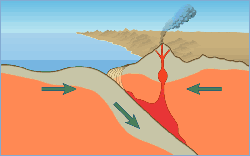 |
|||||||||||||||||||||||||||||||||
|
Volcanoes
In-Depth Keep reading to find out... What causes a volcano to erupt? More than 500 volcanoes are known to have erupted in the time since people started recording history, with more "hidden" eruptions occurring under the sea. The U.S. has had 50 volcanoes erupt, putting it third, behind Indonesia and Japan, in the number of active volcanoes.
A map of the world's volcanoes shows that there are clusters of these extraordinary mountains in specific regions. Most of the world's active volcanoes are located along or near the boundaries between the shifting tectonic plates that make up the earth's surface. These plate-boundary volcanoes include those along the edges of the Pacific Ocean in the "Ring of Fire." The tectonic plates are constantly shifting. If they collide, one plate
may be squeezed down into the earth's mantle (the layer just below the
crust). When this happens, rocks in the plate are pushed towards the interior
of the earth where they become very hot and rise up as magma. If the pressure
continues to increase, this boiling magma will shoot out of its underground
chamber through volcano vents and erupt as lava. Lava appears different depending
on how quickly it flows. Pahoehoe, fast moving lava flows, are
smooth. Aa, slow moving flows, are rough and blocky. |
||||||||||||||||||||||||||||||||

